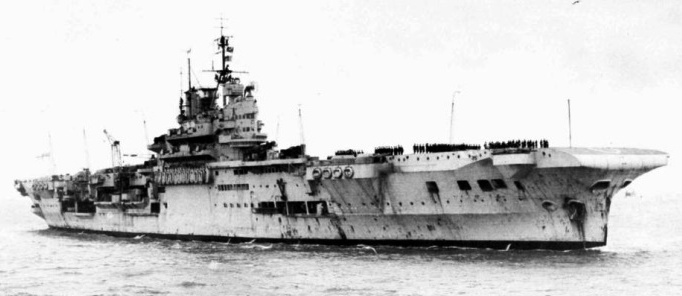SHINYO!
 (Captured EMB under test by an American
soldier)
(Captured EMB under test by an American
soldier)
Explosive Motorboats based
at Hong Kong,
1945
© 2010-2011 Bob Hackett and Sander Kingsepp
Revision 1
 Hong Kong showing Lamma Island
25 December 1941: The Fall of Hong Kong
Hong Kong showing Lamma Island
25 December 1941: The Fall of Hong Kong
MajGen Christopher M. Maltby, British Indian Army, advises Hong Kong's Governor Sir Mark A. Young to surrender the outnumbered British garrison because of lack of food and water. At 1800, Young surrenders the Crown Colony to LtGen Sakai Takashi, CG, 23rd Army. That
night, nearly 6,500 British and Commonwealth troops go into Japanese captivity.
January-February 1945:
The IJN deploys the 35th, 36th and 107th Special Attack Shinyo Squadrons to Hong Kong. The 35 SS has an authorized strength of 185 men and 52 EMBs, 35 SS has 188 men and 50 EMBs, including two Type 5 Shinyo, and 107th SS has 186 men and 25 EMBs,
Lamma Island, Hong Kong. Kamikaze Cave, situated between Lo So Shing and So Kwu Wan, is constructed by the Japanese to house an unknown squadron of Shinyo Explosive Motorboats (EMB).
 (EMBs at Lamma Island)
(EMBs at Lamma Island)
15 August 1945: Cessation of Hostilities:
Imperial Palace, Tokyo. At noon, the Emperor announces Japan's surrender that is broadcast by radio all over the Japanese Empire.
After the news of the Japanese surrender is received, the British Pacific Fleet transfers from USN Pacific Fleet control back to the Royal Navy. That same day, carrier HMS INDOMITABLE (F) departs Sydney via Manus, Admiralty Islands for Subic Bay, Philippines with light carrier HMS VENERABLE and cruisers HMS EURYALUS and SWIFTSURE screened by three fleet destroyers.
 (HMS INDOMITABLE)
(HMS INDOMITABLE)
27 August 1945:
INDOMITABLE departs Subic Bay for Hong Kong, to accept the Japanese surrender and re-establish British control, in Task Group 111.2 consisting of VENERABLE and cruisers SWIFTSURE, BLACK PRINCE and EURYALUS screened by destroyers HMS KEMPENFELT, URSA, QUADRANT and WHIRLWIND.
29 August 1945:
After minesweeping is completed, Rear Admiral (later Admiral, Sir) Charles S. Daniel's battleship HMS ANSON and carrier HMS VENGEANCE join Rear Admiral (later Admiral, Sir) Cecil H. J. Harcourt's British and Commonwealth Task Group 111.2 now also consisting of 14 destroyers, minesweepers, the Eighth submarine flotilla and a hospital ship.
30 August 1945:
Warned of the existence of a Shinyo base on Lamma Island and a rumored attack by EMBs, Admiral Harcourt transfers his flag to cruiser SWIFTSURE and puts Task Group 111.2 on action stations prior to its entry into Hong Kong. At 1200, the British and Commonwealth warships steam into the channel leading to the navy dockyard. [1]
Lamma Bay. SubLt Awamura of the 35th Special Attack Shinyo Squadron sets across the channel in a Shinyo EMB to inform IJN Hq that all warheads have been removed from the squadron's boats. Awamura uses the Shinyo because no other vessel is available, but the anxious British see only that a "suicide boat" has left its moorings. [2]
 (British Seamen with a homemade EMB captured at Hong Kong [3])
(British Seamen with a homemade EMB captured at Hong Kong [3])
With little room to maneuver in the confined waters, Harcourt immediately launches air strikes from INDOMITABLE's and VENERABLE's Air Groups. British TBF "Avenger" torpedo-bombers and F6F "Hellcat" fighters bomb and strafe the EMBs. One is sunk, one beached, and one put back into harbor. Several Japanese are killed - two weeks after the cease-fire.
16 September 1945:
Hong Kong. Government House. Rear Admiral Harcourt accepts the surrender of Japanese forces in the Hong Kong area under MajGen Okada Umekichi and Vice Admiral Fujita Ruitaro (38) (former CO of FUSO). Okada surrenders his Shin-Gunto samurai sword (with general officer's knot) to Admiral Harcourt. Fujita also surrenders his Kai-Gunto samurai sword to Harcourt.

 MajGen Okada and Vice Admiral Fujita sign the instrument of surrender of Hong Kong
MajGen Okada and Vice Admiral Fujita sign the instrument of surrender of Hong Kong
Authors’ Notes:
[1] It is unclear how the British knew of the Japanese EMBs.
[2] On 11 September 1945 , the "China Mail" reported that during the round-up of Japanese forces, men were found on Stonecutters Island who had been organized into a suicide squad operating miniature torpedo boats. The newspaper also reported that "a considerable number of craft were found at Stonecutters." It is unclear if there were locations other than Lamma Island for the concealment of EMBs, or if the correspondent incorrectly stated the location as Stonecutters Island and not Lamma Island.
[3] Several "Shinyo" EMBs are found in the Hong Kong Dockyard, but they are "home made" and powered by engines from old British-built buses that ran in the Colony before the war.
-Bob Hackett and Sander Kingsepp
Back to Explosive
Motorboats Page











